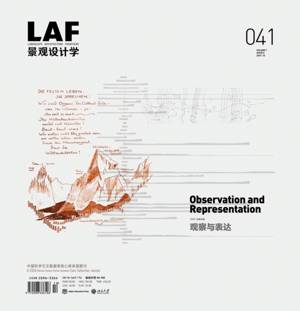
- Afhalen na 1 uur in een winkel met voorraad
- Gratis thuislevering in België vanaf € 30
- Ruim aanbod met 7 miljoen producten
- Afhalen na 1 uur in een winkel met voorraad
- Gratis thuislevering in België vanaf € 30
- Ruim aanbod met 7 miljoen producten
Zoeken
Landscape Architecture Frontiers 041
Observation and Representation
Kongjian Yu, Valerio Morabito, Lu Xiaoxuan, Jill Desimin, Ceng Ying, Leiqing XU, Swa
€ 48,95
+ 97 punten
Omschrijving
Observation and representation is a foundational subject in Landscape Architecture. Landscape design is a process shaped by the connections and interactions among designers, users, and the real world, where designers interpret the uniqueness, qualities, and milieu of sites they observed, understood, experienced, and reinterpret them into tangible elements to communicate and resonate with the users; where users also can experience and get empathized by the conveyed ideas or designed realities, as new observers. Designers' horizon and perception is subject to what they have sensed or learned, as well as individual consciousness and expertise, which also lay a foundation and define the tone of their design work. However, quite a few designers have immersed themselves with design stereotypes or been dogmatically pursuing "justice" or "equality," lacking critical thinking and inclusiveness and compromising creativity. This issue aims to explore the ways that help landscape architects: 1) see the scientism of design disciplines and explore the methodological principles of design generation; 2) translate and convey design ideas and emotional inspiration to the users with rich design vocabulary (in size, shape, material, proportion, composition, etc.) through multiple perceptual approaches; 3) read sites from economic, ecological, cultural, and other perspectives to present more convincing and appealing landscape narratives with the aid of emerging technological means; 4) understand various needs of all parties and stakeholders, coordinating interests and benefits and improving the utilization of public resources through landscape design; and 5) create educational places for improving the public's rational and aesthetic norms. Moreover, it hopes that this issue can demonstrate more possibilities of design thinking and methods through cross-disciplinary exchange to make landscape architects understand their roles and the realities better. For instance, in Art Theory "observation and presentation" is more about the logic, medium, and approaches of representation with a respect to individual interpretations on the society, economy, politics, and culture of the real world, which glows as a valuable reference and supplement to the circumstances of landscape architecture.
Specificaties
Betrokkenen
- Auteur(s):
- Uitgeverij:
Inhoud
- Aantal bladzijden:
- 144
- Taal:
- Engels
- Reeks:
Eigenschappen
- Productcode (EAN):
- 9781943532926
- Verschijningsdatum:
- 21/07/2020
- Uitvoering:
- Paperback
- Formaat:
- Trade paperback (VS)
- Afmetingen:
- 279 mm x 290 mm
- Gewicht:
- 839 g

Alleen bij Standaard Boekhandel
+ 97 punten op je klantenkaart van Standaard Boekhandel
Beoordelingen
We publiceren alleen reviews die voldoen aan de voorwaarden voor reviews. Bekijk onze voorwaarden voor reviews.











